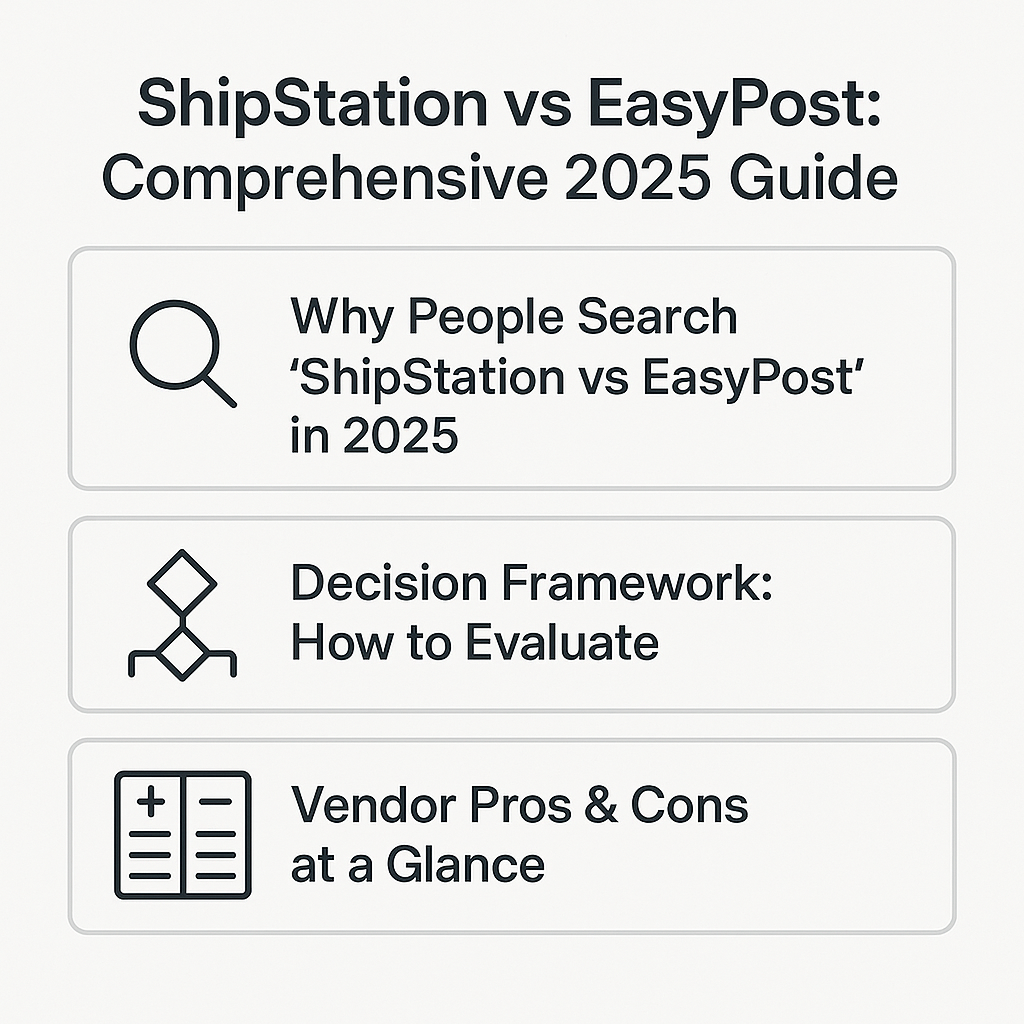
ShipStation vs EasyPost
Choosing between ShipStation and EasyPost can feel daunting, especially when your business’s logistics efficiency is on the line. This guide promises to illuminate the key differences, helping you make a confident decision.
Why People Search ‘ShipStation vs EasyPost’ in 2025
In 2025, the logistics landscape is rapidly evolving with new technologies and sustainability pressures. Logistics managers and ecommerce founders are increasingly searching for solutions that integrate AI forecasting and sustainable practices. ShipStation and EasyPost are two prominent players that offer distinct advantages and challenges. Understanding these can be crucial for businesses aiming to stay competitive.
- AI integration is a key differentiator; evaluate how each platform leverages AI for predictive analytics.
- Consider sustainability features; look for platforms offering eco-friendly shipping options.
- Assess scalability; ensure the solution can grow with your business needs.
Decision Framework: How to Evaluate
When evaluating ShipStation vs EasyPost, it’s essential to align your choice with your business’s operational goals. Start by identifying the primary logistics challenges you face, such as cost management, speed of delivery, or integration capabilities. This will guide your evaluation process.
Consider the user experience each platform offers. A seamless interface can significantly reduce training time and improve operational efficiency. Additionally, examine the integration capabilities with your existing systems, as this will impact the ease of adoption and ongoing management.
- Define your logistics priorities: cost, speed, or integration.
- Evaluate user interface and ease of use for your team.
- Check compatibility with existing systems for smooth integration.
Vendor Pros & Cons at a Glance
- ShipStation Pros: User-friendly interface, robust integration options, strong customer support.
- ShipStation Cons: Higher costs for premium features, limited customization for complex needs.
- EasyPost Pros: Flexible API, cost-effective for high-volume shippers, extensive carrier network.
- EasyPost Cons: Steeper learning curve, less intuitive for non-technical users.
ShipStation is often praised for its ease of use and customer support, making it ideal for businesses prioritizing user experience. EasyPost, with its flexible API and cost-effectiveness, appeals to tech-savvy operations looking for customization and scalability.
Pricing & Total Landed Cost: What Really Moves the Number
Understanding the pricing models of ShipStation and EasyPost is crucial for managing your logistics budget effectively. ShipStation typically offers tiered pricing based on shipment volume, which can be advantageous for small to medium-sized businesses. EasyPost, on the other hand, charges based on API usage, making it more predictable for high-volume shippers.
- ShipStation: Tiered pricing, beneficial for scaling businesses.
- EasyPost: API usage-based pricing, predictable for high-volume operations.
- Consider hidden costs like integration fees or premium support charges.
While ShipStation’s tiered pricing might be more straightforward for smaller operations, EasyPost’s model can offer significant savings for businesses with high shipping volumes, provided they can manage the technical integration.
Feature-by-Feature Comparison
- Integration: ShipStation offers a wide range of plug-and-play integrations, while EasyPost provides a flexible API for custom solutions.
- User Interface: ShipStation is known for its intuitive interface, whereas EasyPost may require more technical expertise.
- Carrier Options: EasyPost supports a broader range of carriers, offering more flexibility in shipping options.
- Support: ShipStation provides robust customer support, ideal for businesses needing hands-on assistance.
ShipStation’s ease of use and support make it a strong contender for businesses seeking a straightforward solution. EasyPost’s flexibility and carrier options cater to those needing a more tailored approach.
Scenario Playbook: Who Should Choose What?
- Small to Medium Businesses: ShipStation is ideal due to its user-friendly interface and strong support.
- Tech-Savvy Operations: EasyPost offers flexibility and cost savings for businesses with technical resources.
- High-Volume Shippers: EasyPost’s API pricing can lead to significant savings.
For smaller businesses or those without dedicated IT resources, ShipStation’s simplicity and support are invaluable. Conversely, tech-driven companies that can leverage EasyPost’s API will find it more adaptable and potentially more cost-effective.
Onboarding & Risk Mitigation
Onboarding with ShipStation is generally straightforward, thanks to its intuitive interface and comprehensive support resources. EasyPost, while offering a powerful API, may require more technical expertise during setup. It’s crucial to allocate sufficient resources for onboarding to mitigate potential risks and ensure a smooth transition.
- Allocate time for training and onboarding, especially with EasyPost.
- Utilize available support resources to minimize downtime during transition.
- Plan for potential integration challenges and have a contingency plan.
Expert Take
Having worked with both platforms, I recall a client who initially chose ShipStation for its ease of use. As their operation scaled, they transitioned to EasyPost to leverage its API for custom solutions. This highlights the importance of aligning platform choice with both current needs and future growth plans.
Further Reading
FAQs
How do pricing models differ for ‘ShipStation vs EasyPost’?
ShipStation uses tiered pricing based on shipment volume, while EasyPost charges based on API usage.
What support model should I expect?
ShipStation offers robust customer support, whereas EasyPost may require more technical expertise.
Which industries benefit most?
Small to medium businesses benefit from ShipStation, while tech-savvy, high-volume shippers might prefer EasyPost.
How long does onboarding take?
ShipStation’s onboarding is typically quicker due to its intuitive interface, while EasyPost may require more technical setup time.
Can multi-node reduce both cost and transit time?
Yes, both platforms support multi-node logistics, which can optimize cost and transit time.
Next Steps
Ready to make a decision? Compare quotes or schedule a consultation to determine which platform best suits your logistics needs.

Leave a Reply